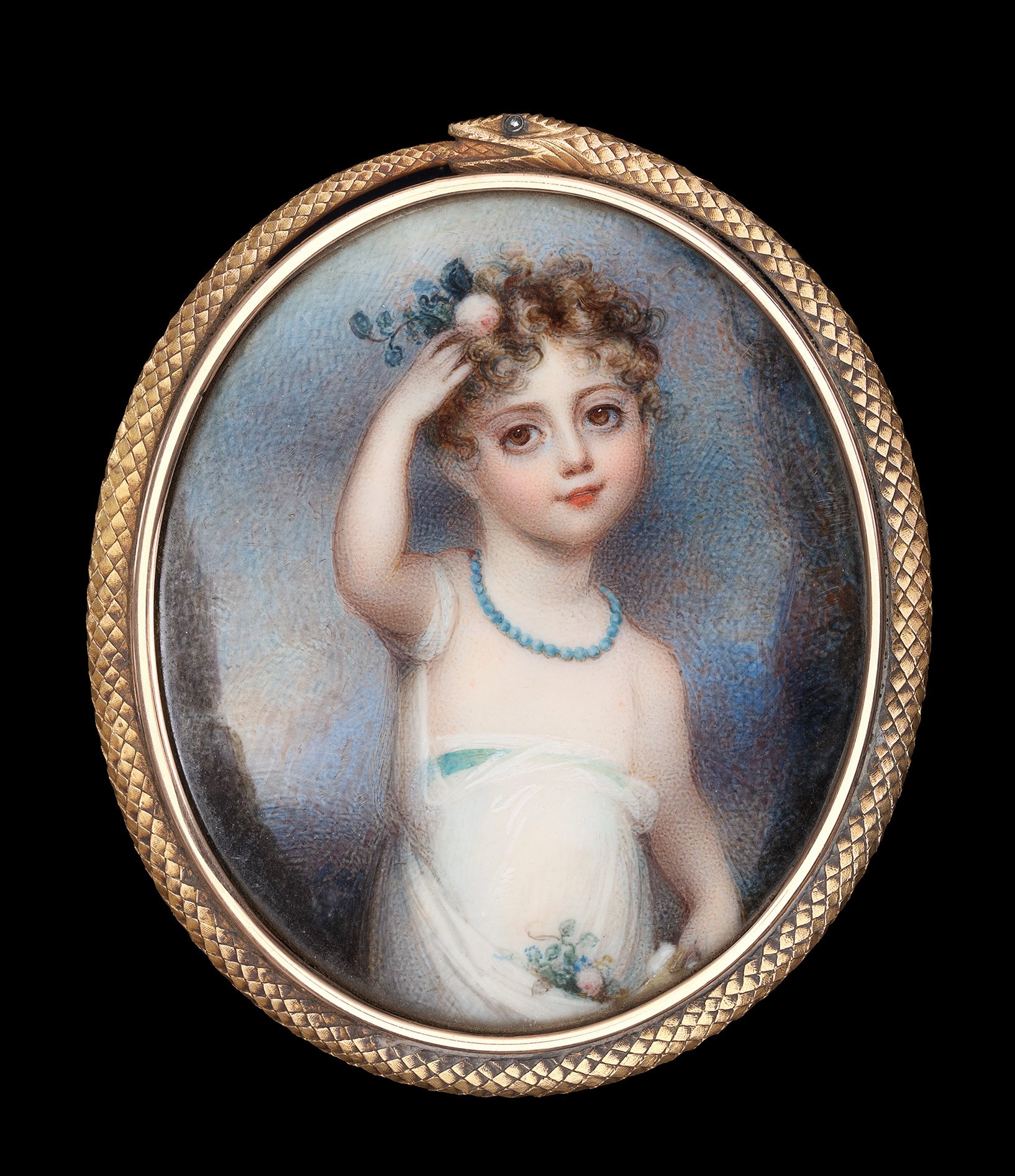ANNE MEE (née Foldsone) (circa 1770-1851)
Portrait miniature of a Child, wearing white gown, holding flowers to their curled hair and in their skirt, landscape background; circa 1795
Watercolour on ivory
Ivory registration number: D24VMYDY
Set into a gold ouroboros frame, the reverse glazed to reveal hair
Oval, 80mm (3 ¼ in) high
Provenance: Private Collection, UK.
SOLD
“Mee’s father’s death around this time forced her to begin painting as a profession, possibly with some financial support from George Romney..”
Anne Mee was one of the most successful professional women artists of the late nineteenth and early nineteenth century. Her self-portrait, engraved by Henry Richard Cook, shows her looking out proudly at the viewer, her long neck emphasised by her cropped hair.[1]
Like many women artists of this period, Anne learned her craft from a family member – in her case, her father, John Foldsone (d. 1784). He earned his living as a portrait painter, but his work appears to have driven by quantity, rather than quality, as he was described as charging 'a guinea the piece, or less, rather than lose the sitter was taken'.[2]
It appears that he had grander plans for Anne, who was sent to the eighteenth-century version of a finishing school, called Madame Poimier’s, in Queen Square, Westminster, where her talent as an artist was revealed. After helping her father in his studio, Anne was well-versed in the practicalities of painting and was apprenticed to the society portrait painter George Romney in her early teens. Her father’s death around this time forced her to begin painting as a profession, possibly with some financial support from Romney. Sitting to Mee when she was just eighteen years old, the poet William Hayley described her as a 'young female genius in miniature' and 'a pretty, modest and sensible girl' (Long, 218).[3]
Mee’s star continued to rise as she was introduced to Queen Charlotte and given a residence at Windsor Castle. Miniatures of the princesses Sophia, Amelia, and Charlotte by Miss Foldsone remain in the Royal Collection.
Mee’s marriage to Joseph Lee, an Irish barrister, in 1793, apparently curbed the clientele she was able to paint. In his diary, Joseph Farington recorded a comment made that after her marriage she was only allowed to paint female subjects. This did not, however, preclude gaining a commission from the new king, George IV, who asked her to paint a ‘gallery of beauties’, a series of nineteen portraits of court women begun in 1812 and completed in 1814. She also raised six children with her husband, one of her sons, Arthur, becoming articled to the architect Sir John Soane.
Although Mee’s miniatures have often attracted criticism, with art historians Basil Long and Richard Walker slating her colouring as ‘displeasing’ (Long) and her portraits as ‘flashy, affected and melodramatic’ (Walker), she was clearly a successful artist, with a long career which attracted patrons from nobility and royalty – she far exceeded her father as an artist.
The present work is exceptional in Mee’s oeuvre. At over three inches in height it is a large portrait miniature for the period. Representing a lively toddler, it is not possible to know for certain whether this is a male or female child, as the colour blue was yet to be gendered by this date. However, the flowers and beaded necklace suggest that this is more likely to be a girl. The gold ouroboros frame – a serpent eating its own tail – was used an as emblem for eternity. It is therefore possible in this instance that the child died young.
[1] A version in the National Portrait London, Published 1 January 1814; NPG D14792
[2] Court and private life in the time of Queen Charlotte, being the journals of Mrs Papendiek, ed. V. D. Broughton, 2 vols. (1887), vol. 2, 144.
[3] Basil Long, p. 218.



